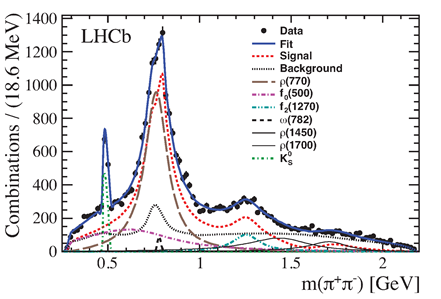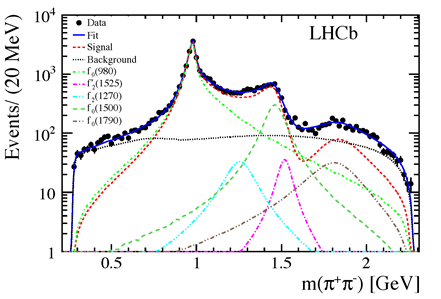The LHCb Collaboration has published today a paper which shows that the f0(500) and the f0(980) mesons, long thought to be four quark states (tetraquarks) made out of the light udud quarks (f0(500)) or susu quarks (f0(980)), are NOT consistent with being tetraquarks. The four quark states cannot be classified within the traditional quark model in which the strongly interacting particles (hadrons) are formed either from quark-antiquark pairs (mesons) or three quarks (baryons). They are therefore called exotic particles.
The Collaboration has studied the B0→J/ψπ+π− decays. The left image below shows that the π+π− invariant mass distribution is well understood as a contribution of different resonances and background distribution. The broad contribution of f0(500) is clearly seen in the data. Note that the narrow K0s peak structure is seen in the same mass region. There is no, however, evidence for the f0(980) contribution. The f0(980) production is much smaller than that predicted for tetraquarks and is ruled out at the 8σ level. The tetraquark model predicts a much smaller difference in the production rates of the two f0 mesons. The right image below shows the corresponding π+π− invariant mass distribution for the B0s→J/ψπ+π− decays. The contribution of f0(980) is clearly visible. The absence of f0(980) in B0 decays and its presence in B0s decays as well as the presence of f0(500) in B0 decays and its absence in B0s decays is exactly what is expected if these states are normal qq states. Read more in the LHCb publication here.
click the images for higher resolution
The precision of the LHCb detector and high production rate at the LHC allowed the LHCb Collaboration to made an important contribution to the understanding of exotic state candidates with heavy charm quarks inside, and to draw conclusions which of them are really exotic and which are not. Recently the Collaboration observed the Z(4430) particle and established its quantum numbers which make it the first confirmed unambiguous tetraquark (cucd), see 9 April 2014 news located just below at this page. This observation has implications to astrophysics and was followed up by an impressive media coverage.
The story of the X(3872) particle is more complicated. It was discovered about 10 years ago by the Belle Collaboration and since then was also studied by other experiments. The mass of 3872 MeV is located in a region where the pairs of charm (D) and anti-charm D mesons can be formed. In this mass region many charm quark-antiquark (cc) states are also present bound by a strong force in an atom-like system called charmonium. In addition the two different forms of exotic particles can be formed in this mass region: 1. About 10 fm large loosely bound DD* molecules in which D and D mesons are bound by a strong force in analogy to the deuterium nucleus composed of a proton and a neutron, and 2. About 1 fm compact four quark qqqq elementary particles, tetraqarks.
The LHCb has unambiguously determined the quantum numbers of X(3872) to be 1++, see 26 February 2013 news . This are the quantum numbers of an as yet unobserved charmonium state called χc1(23P1). However, the charmonium spectrum is very well understood and the mass of the X(3872) makes this assignment very unlikely. The LHCb measurement of the ratio of branching fractions of X(3872) decay into ψ(2S)γ and J/ψγ does not support a pure DD* molecule interpretation of the X(3872), see 24 March 2014 news, and favours a hypothesis for an admixture of cc charmonium state and DD* molecule. However, the relativelly high production cross-section of the X(3872) at the LHC observed by the LHCb Collaboration, see 27 October 2010 news, favours even more an exotic tetraquark compact particle interpretation. More studies of X(3872) production and decay properties are needed to clarify its internal structure.


